Abstract
Frullania dorsimamillosa is described as new to science based on collections from northeastern Sichuan, China. The closely related F. chinlingensis from Shaanxi has been erroneously treated as a synonym of F. dilatata and has to be resurrected. The distinguishing features are discussed and a determination key is provided. Frullania dorsimamillosa and F. chinlingensis are ascribed to F. subg. Frullania and are unique in having conspicuous protrusions on the dorsal leaf surface. The development of papillae-like structures is considered to be an ecophysiological adaptation primarily aiding for light reflection and for water uptake.

